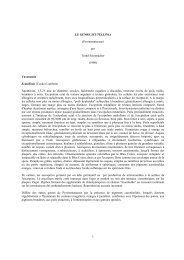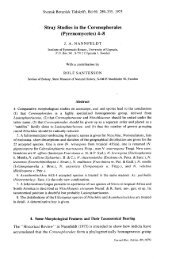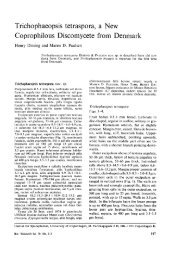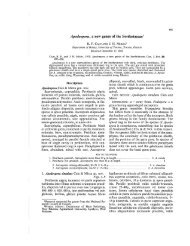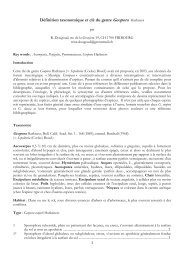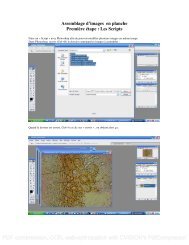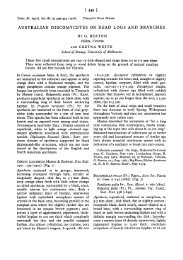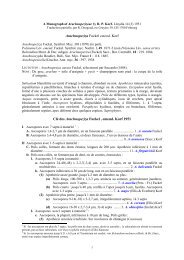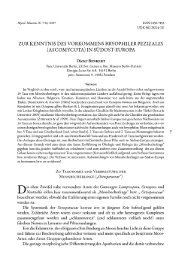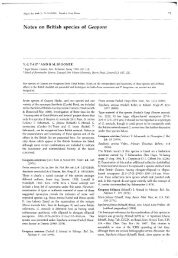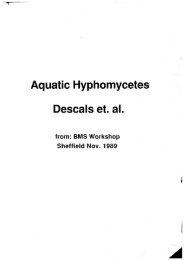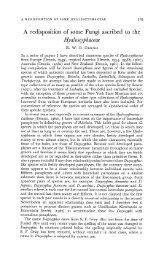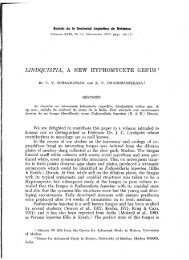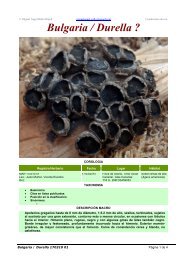Forums > Ascomycetes - ASCOfrance
Forums > Ascomycetes - ASCOfrance
Forums > Ascomycetes - ASCOfrance
Create successful ePaper yourself
Turn your PDF publications into a flip-book with our unique Google optimized e-Paper software.
<strong>ASCOfrance</strong><br />
http://www.ascofrance.fr/index.phpr=forum&page=viewtopic&id=10909<br />
1 de 18 20/04/2010 18:34<br />
Votre compte<br />
| Se déconnecter<br />
Miguel Ángel Ribes, bienvenue sur <strong>ASCOfrance</strong>.com<br />
English Version<br />
Chercher<br />
Accueil<br />
Introduction à l'étude des Pyrenomycetes<br />
Mise en culture<br />
AscoMelle 2008<br />
Rechercher dans la base<br />
Proposer une fiche<br />
<strong>Forums</strong><br />
Liens<br />
Documentations<br />
Me contacter<br />
<strong>Forums</strong> > <strong>Ascomycetes</strong><br />
Nouveau sujetRépondre<br />
Notification par email<br />
Recevoir un email à chaque réponse à ce message<br />
Bulgaria <br />
Good night<br />
I have this black asco on Agave americana, from Gran Canaria (Canary Islands), 6 mm diameter, 2 mm tall. Spores eliptical, dark brown, one<br />
central gutule, finely warted. Asci cylindrical, inoperculate, IKI+, with croziers. Parafisis cylindrical with yellow gutules.<br />
I do not find anything so (Bulgaria, Durella, Patellaria...)<br />
Sporal measures (1000x, in water, fresh material)<br />
13.1 [14.1 ; 14.4] 15.4 x 8.4 [9.1 ; 9.3] 9.9<br />
Q = 1.4 [1.5 ; 1.6] 1.7 ; N = 80 ; C = 95%<br />
Me = 14.27 x 9.18 ; Qe = 1.56<br />
Thank you<br />
Miguel<br />
Cliquez sur cette image pour l'afficher en grand<br />
Téléchargez le document lié à ce message<br />
__________<br />
Miguel Ángel Ribes<br />
le 29/03/2010 à 01:30<br />
modifier ce message<br />
Re:Bulgaria
<strong>ASCOfrance</strong><br />
http://www.ascofrance.fr/index.phpr=forum&page=viewtopic&id=10909<br />
2 de 18 20/04/2010 18:34<br />
I have no idea what this is. Nothing to do with Durella or Patellaria for sure, Bulgaria I also do not believe to be closely related. Perhaps more with<br />
encoelioid fungi.<br />
Interesting is the thick gel sheath around the spores. The spores appear to be shot when brown.<br />
Bulgariella seems also different in superficial apos without a raised margin (yours appear to be closed when young), and inamyloid asci. The<br />
paraphyses would quite fit (yours contain large round VBs when intact). What about the excipulum on the flanks, is it of angularis In Bulgariella<br />
it is of a horizontal prismatica-porrecta, with granular walls.<br />
Zotto<br />
__________<br />
Hans-Otto Baral<br />
le 30/03/2010 à 00:09<br />
Re:Bulgaria <br />
I am not completly sure about de excipulum on the flanks, I think it is mixed angularis-prismatica. Perhaps I have not made a good cut.<br />
Cliquez sur cette image pour l'afficher en grand<br />
__________<br />
Miguel Ángel Ribes<br />
le 30/03/2010 à 01:47<br />
modifier ce message<br />
Re:Bulgaria <br />
The second<br />
Cliquez sur cette image pour l'afficher en grand<br />
__________<br />
Miguel Ángel Ribes<br />
le 30/03/2010 à 01:48<br />
modifier ce message<br />
Re:Bulgaria <br />
The third<br />
Cliquez sur cette image pour l'afficher en grand<br />
__________<br />
Miguel Ángel Ribes<br />
le 30/03/2010 à 01:48<br />
modifier ce message
<strong>ASCOfrance</strong><br />
http://www.ascofrance.fr/index.phpr=forum&page=viewtopic&id=10909<br />
3 de 18 20/04/2010 18:34<br />
Re:Bulgaria <br />
And the last. I have some more photos, but I think they are worst than this.<br />
Thank you Zotto<br />
Miguel<br />
Cliquez sur cette image pour l'afficher en grand<br />
__________<br />
Miguel Ángel Ribes<br />
le 30/03/2010 à 01:49<br />
modifier ce message<br />
Re:Bulgaria <br />
Dear Miguel<br />
Your sections are good enough. But there is a wine-red pigment. Did you test with KOH what it does dissolve in the medium change its colour<br />
Zotto<br />
__________<br />
Hans-Otto Baral<br />
le 30/03/2010 à 11:34<br />
Re:Bulgaria <br />
Dear Zotto<br />
No, the photos are made with tap water. I still have ascomas fresh in my fridge, so if you want, today I am going to test it with KOH.<br />
Miguel,<br />
__________<br />
Miguel Ángel Ribes<br />
le 30/03/2010 à 12:47<br />
modifier ce message<br />
Re:Bulgaria <br />
I have no clear idea of the relationship within the Helotiales, therefore any character will be helpful. I also suggest to stain the gel of the spores<br />
with cresyl blue in order to see it better. In the case it does not stain I would use indian ink (as far as I know) to see its exact limits of the gel, or<br />
phase contrast, or simply by more closing the microscope aperture.<br />
Zotto<br />
__________<br />
Hans-Otto Baral<br />
le 30/03/2010 à 16:30<br />
Re:Bulgaria <br />
Is this the gel are we finding With cresyl bleu.<br />
Miguel<br />
Téléchargez le document lié à ce message<br />
__________<br />
Miguel Ángel Ribes<br />
le 30/03/2010 à 18:12<br />
modifier ce message<br />
Re:Bulgaria <br />
This is the excipulum with KOH 5%, the color does not change.
<strong>ASCOfrance</strong><br />
http://www.ascofrance.fr/index.phpr=forum&page=viewtopic&id=10909<br />
4 de 18 20/04/2010 18:34<br />
Could I make any more test<br />
Miguel<br />
Cliquez sur cette image pour l'afficher en grand<br />
__________<br />
Miguel Ángel Ribes<br />
le 30/03/2010 à 18:36<br />
modifier ce message<br />
Re:Bulgaria <br />
One more with KOH 5%<br />
Cliquez sur cette image pour l'afficher en grand<br />
__________<br />
Miguel Ángel Ribes<br />
le 30/03/2010 à 18:38<br />
modifier ce message<br />
Re:Bulgaria <br />
And the last one excipulum/subexcipulum with KOH 5%<br />
Thanks again, Zotto<br />
Cliquez sur cette image pour l'afficher en grand<br />
__________<br />
Miguel Ángel Ribes<br />
le 30/03/2010 à 18:39<br />
modifier ce message<br />
Re:Bulgaria <br />
Interesting that the gel does not stain, and that the pigment does not change. Did you add the KOH to the water mount (you probably lnow the<br />
ionomidotic reaction: abundant pigment extrudes in the medium when KOH reaches the tissue).<br />
Did you ask Esperanza about this fungus The disc is really 6 mm diam<br />
Zotto<br />
__________<br />
Hans-Otto Baral<br />
le 30/03/2010 à 22:09
<strong>ASCOfrance</strong><br />
http://www.ascofrance.fr/index.phpr=forum&page=viewtopic&id=10909<br />
5 de 18 20/04/2010 18:34<br />
Re:Bulgaria <br />
Sorry, I added the KOH directly to the sample, but I just repeat now adding the KOH to the water mount and the results are exactly the same, the<br />
pigment is not extrudes.<br />
I have not asked anyone about this Ascomycete. I'm really surprised because their macro features, its large size (I confirm the 6 mm diameter, I<br />
have fresh material and I have measure it again), their habitat and so particular micro, made me think the identification would be immediate. ¿<br />
Thanks Zotto, you are very kind, as always.<br />
Miguel<br />
__________<br />
Miguel Ángel Ribes<br />
le 30/03/2010 à 23:55<br />
modifier ce message<br />
Re:Bulgaria <br />
I was thinking that this species might be introduced from America as the host is Agave. But I do not find that genus in Seaver's (1951) host index.<br />
When I look through Seaver's images, I find only the genus Sphaerangium Seaver (= Phaeangium Sacc. p.pt.) with 3 species. Here the ellipsoid<br />
spores become brown and partly have a gel envelope, but are much larger. No mention of an internal pigment, nor the iodine reaction.<br />
Zotto<br />
__________<br />
Hans-Otto Baral<br />
le 31/03/2010 à 16:15<br />
Re:Bulgaria <br />
Sorry the delay, I have been a long weekend 4 days.<br />
That is a good way, I will find Sphaerangium, but I have not biblio, so it is difficult to identify it for me.<br />
Thanks again Zotto.<br />
__________<br />
Miguel Ángel Ribes<br />
le 04/04/2010 à 23:02<br />
modifier ce message<br />
Re:Bulgaria <br />
Hymenobolus agaves Durieu & Mont. (c.n. Coniothyrina agaves)<br />
In Sylloge Fungorum c'è un errore: non planche 28 f.2 ma planche 29 f.2 dell'Atlas di Durieu. Ciao<br />
Cliquez sur cette image pour l'afficher en grand<br />
__________<br />
Carlo Agnello<br />
le 05/04/2010 à 12:45<br />
Re:Bulgaria <br />
Hey Carlo, excellent. The macro fits perfectly.<br />
Anyone has micro description<br />
Thankk you very much,<br />
Miguel<br />
__________<br />
Miguel Ángel Ribes<br />
le 05/04/2010 à 18:05
<strong>ASCOfrance</strong><br />
http://www.ascofrance.fr/index.phpr=forum&page=viewtopic&id=10909<br />
6 de 18 20/04/2010 18:34<br />
modifier ce message<br />
Re:Bulgaria <br />
Hi Miguel,<br />
here you can see the complete description of the new combination (1927)<br />
pag. 322, 323, 324<br />
http://bibdigital.rjb.csic.es/ing/Libro.phpLibro=...<br />
bye<br />
__________<br />
Carlo Agnello<br />
le 05/04/2010 à 18:36<br />
Re:Bulgaria <br />
This is actually great! I read the description in Saccardo 1889: 587, and this fits very well in spore size and colour. No mention of iodine reaction,<br />
or excipular color, see attach.<br />
But there is an error in Index fungorum: Petrak & Sydow 1927 combined a different species, a conidial fungus, Phoma agaves Dur. & Mont., to<br />
Coniothyrina, and this is said to be the anamorph of Stomatogene agaves (Ell. & Ev.) Theiß by Petrak & Sydow.<br />
Hymenobolus was described by Montagne in 1845, with H. agaves as monotype, see here:<br />
Zotto<br />
Cliquez sur cette image pour l'afficher en grand<br />
Téléchargez le document lié à ce message<br />
__________<br />
Hans-Otto Baral<br />
le 05/04/2010 à 21:06<br />
Re:Bulgaria <br />
Ok Zotto. I initially read the description in Saccardo SF and Montagne but I was wrong to trust IndexFungorum...<br />
Thank you. Bye<br />
__________<br />
Carlo Agnello<br />
le 05/04/2010 à 22:25<br />
Re:Bulgaria <br />
Internet is wonderful and your are very great.<br />
Petrak and Sydow's paper is imposible to me, and Google german translator is really bad. Thanks anyway Carlo, your image (Durieu) is really<br />
clear. Papers about Hymenobolus agaves fits Ok, thanks Zotto.<br />
Best regards,<br />
Miguel<br />
__________<br />
Miguel Ángel Ribes<br />
le 06/04/2010 à 00:44<br />
modifier ce message<br />
Re:Bulgaria <br />
Carlos, did you find Durieu & Montagne on the web or do you have it at home I would like to look more in this Algerien atlas, what other fungi
<strong>ASCOfrance</strong><br />
http://www.ascofrance.fr/index.phpr=forum&page=viewtopic&id=10909<br />
7 de 18 20/04/2010 18:34<br />
they have there. Possibly this Hymenobolus has never been recorded again<br />
Zotto<br />
__________<br />
Hans-Otto Baral<br />
le 06/04/2010 à 13:14<br />
Re:Bulgaria <br />
Hello Zotto. Durieu "Atlas - Exploration scientifique de l'Algerie" is available here about 15-16 months ago with many beautiful mushrooms of<br />
Leveille and Montagne ...Peziza ammophila, Helvella helvellula, etc. etc... It's so nice that I could not resist printing it ! http://bibdigital.rjb.csic.es<br />
/spa/Libro.phpLibro=...<br />
Ciao<br />
__________<br />
Carlo Agnello<br />
le 06/04/2010 à 17:27<br />
Re:Bulgaria <br />
What a wonderful atlas!!<br />
Miguel,<br />
__________<br />
Miguel Ángel Ribes<br />
le 06/04/2010 à 18:22<br />
modifier ce message<br />
Re:Bulgaria <br />
Thanks, I downloaded pl. 27-31. Exceptional!<br />
text about ascos is a lot: p. 443-563.<br />
Zotto<br />
__________<br />
Hans-Otto Baral<br />
le 06/04/2010 à 20:33<br />
Re:Bulgaria <br />
Hi Zotto,<br />
You have a collection in Jaap O. 1915 Siebentes Verzeichnis zu meinem Exsikkatenwerk "Fungi selecti exsiccati". Serien XXV bis XXVIII<br />
(Nummern 601-700), nebst Beschreibungen neuer Arten und Bemerkungen. Verh. d. bot. Ver. d. Prov. Brandenb. 57 : 8-25.<br />
But I don't have this paper.<br />
Best, Guy<br />
__________<br />
guy Garcia<br />
le 06/04/2010 à 20:48<br />
Re:Bulgaria <br />
Hi Guy<br />
I do not know what you mean. Jaap 1915 I do not have in my database, I think I do not have a copy.<br />
What collection do you mean<br />
Zotto<br />
__________<br />
Hans-Otto Baral<br />
le 06/04/2010 à 20:52<br />
Re:Bulgaria <br />
In Sylloge Fungorum Vol. III, Saccardo, page 317 it appears like Coniothyrium concentricum var. agaves in Italia, Lusitania and Austria. And in<br />
page 318 like Coniothyrium agaves, in Argelia.<br />
Miguel,<br />
Téléchargez le document lié à ce message<br />
__________<br />
Miguel Ángel Ribes<br />
le 06/04/2010 à 20:54
<strong>ASCOfrance</strong><br />
http://www.ascofrance.fr/index.phpr=forum&page=viewtopic&id=10909<br />
8 de 18 20/04/2010 18:34<br />
modifier ce message<br />
Re:Bulgaria <br />
You have a collection "Aus Österreich sind angeführt: 678. Hymenobolus agaves Dur. et Mont. auf Agave, Lesina"<br />
__________<br />
guy Garcia<br />
le 06/04/2010 à 21:06<br />
Re:Bulgaria <br />
Bonsoir Miguel,<br />
Dans le tome 3 du Sylloge il ne s'agit pas de la même espèce C'est un Phoma.<br />
__________<br />
guy Garcia<br />
le 07/04/2010 à 23:29<br />
Re:Bulgaria <br />
Hello Guy<br />
At Index fungorum and Mycobank appear Coniothyrium agaves like a synonymy of Coniothyrina agaves. Different question is Coniothyrina<br />
concentricum var. agaves. Perhaps I am wrong reading the handwritten words at the margin in page 317, nº 67 "probabili... C. agaves (Mont.)<br />
Sacc. ... Hispania" and in page 318, nº 70 "An eaden ac var. Agaves Coniothirii concentrici". Am I wrong<br />
I am very awkward with taxonomic issues, sorry.<br />
Miguel,<br />
__________________________________________________ ____________<br />
Index fungorum<br />
Coniothyrina agaves (Durieu & Mont.) Petr. & Syd., Repert. Spec. Nov. Regni Veg. Beih. 42(1): 322 (1927) [1926]<br />
Synonymy:<br />
Clisosporium agaves (Mont.) Kuntze, Revis. gen. pl. (Leipzig) 3: 458 (1898)<br />
Coniothyrium agaves (Durieu & Mont.) Sacc., Syll. fung. (Abellini) 3: 318 (1884)<br />
Hymenobolus agaves Durieu & Mont.<br />
__________<br />
Miguel Ángel Ribes<br />
le 08/04/2010 à 15:10<br />
modifier ce message<br />
Re:Bulgaria <br />
In any case, there is a Phoma agaves Durieu & Mont. in Index fungorum, and this is the basionym of Coniothyrina agaves, whereas Hymenobolous<br />
agaves has nothing to do with this anamorphic fungus.<br />
Zotto<br />
__________<br />
Hans-Otto Baral<br />
le 08/04/2010 à 20:15<br />
Re:Bulgaria <br />
Bonsoir,<br />
Comme Zotto l'a déjà précisé c'est une erreur du site de Kew (index fungorum) reprise par de nombreux autres sites qui copient sans vérifier les<br />
informations diffusées par Kew.<br />
Sur feuilles de Agave americana, Durieu et Montagne ont décrit deux champignons bien distincts :<br />
Hymenobolus agaves Durieu & Mont. 1845 Ann. Sci. Nat. sér. 3, tome 4 : 360, Atlas pl. 29, f. 2 [typus generis] Ce basionyme n'a pas été combiné<br />
dans un autre genre.<br />
Phoma agaves Durieu & Mont. 1856 in Montagne Sylloge generum specierumque Plantarum cryptogamarum p. 271 n°980<br />
__________<br />
guy Garcia<br />
le 08/04/2010 à 21:22<br />
Re:Bulgaria <br />
Thank you, Guy and Zotto<br />
Now I have understand it, sorry. My species is Hymenobolus agaves Dur. & Mont. (1845).
<strong>ASCOfrance</strong><br />
http://www.ascofrance.fr/index.phpr=forum&page=viewtopic&id=10909<br />
9 de 18 20/04/2010 18:34<br />
And Coniothyrina agaves (Phoma agaves, Coniothyrium agaves, Coniothyrium concentricum var. agaves, Coniothyriella agavicola) is another<br />
anamorphic species very diferent. Ok.<br />
Ufff. taxonomy is my downfall.<br />
Miguel<br />
__________<br />
Miguel Ángel Ribes<br />
le 09/04/2010 à 09:56<br />
modifier ce message<br />
Re:Bulgaria <br />
Dear Guy & Miguel<br />
I just read the contribution by Höhnel 1918 about Hymenobolus. Here the first problems arise. Höhnel examined a find from Dalmatia by Jaap<br />
(perhaps this belonged to Austria at that time).<br />
Although ascus and spore size fit quite well, Höhnel gives the iodine reaction as negative. Variation in iodine reaction occurs sometimes in<br />
discomycetes, but a further detail is more surprizing: The ectal excipulum is found to have an outer golden-yellow layer and an inner dark brown<br />
layer. The yellow layer is 20-70 µm thick and consists of a "waxy" substance in which narrow (1.5-2 µm) hyphae are embedded. This layer is said<br />
to break easily into clods and detaches, so that mature apothecia show only a yellowish pruina on their exterior. Höhnel thought that this could<br />
belong in the Pezizales.<br />
On Miguel's photos I see a purplish ectal excipulum, and I remember that KOH did not change the colour. I would not term this brown. So I feel<br />
there are some problems in the identity of this collection.<br />
Zotto<br />
__________<br />
Hans-Otto Baral<br />
le 10/04/2010 à 17:59<br />
Re:Bulgaria <br />
Hello everyone.<br />
Are known at least two findings sub Hymenobolus agaves by Portugal (Torrend in Broteria 2:147).<br />
I want to ask what you know about Bulgaria agaves Rabenh. <br />
Ciao<br />
__________<br />
Carlo Agnello<br />
le 10/04/2010 à 20:20<br />
Re:Bulgaria <br />
Bulgaria agaves Rabenh. is mentioned by Höhnel. It is apparently a herbarium name, which means it is invalid. Höhnel did not see the specimen<br />
nor does he mention its geographical origin, but he considers that it might belong to the same species as Hymenobolus agaves.<br />
Zotto<br />
__________<br />
Hans-Otto Baral<br />
le 10/04/2010 à 20:56<br />
Re:Bulgaria <br />
Excuse me Zotto,<br />
but could not be just a matter of change of the pigment due to the old herbarium material from purplish to brown <br />
The ectale in Miguel photos conforms to the description of Hohnel...<br />
Thank you<br />
Cliquez sur cette image pour l'afficher en grand<br />
__________<br />
Carlo Agnello
<strong>ASCOfrance</strong><br />
http://www.ascofrance.fr/index.phpr=forum&page=viewtopic&id=10909<br />
10 de 18 20/04/2010 18:34<br />
le 11/04/2010 à 06:32<br />
Re:Bulgaria <br />
You think the purplish changes to brown Yes, that might be possible. But the yellow in the old herbarium material should be visible in Miguel's<br />
material, at least in young apothecia. Together with the iodine reaction I am sceptical about Jaap's collection. So the type of H. agaves could have<br />
either the features of Miguel's or those of Jaap's fungus. I do not remember a colour of the excipulum in transmitted light in the protologue. I fear<br />
that a type study becomes necessary.<br />
That different though very closely related species inhabit the same host is not very unusual, in my experience.<br />
Finally, the question is still open whether this fungus (or two fungi) originally come from America, i.e. whether they are confined to Agave as<br />
substrate. I am also not sure whether this fungus is drought-tolerant, a matter which Miguel could find out (rehydrate the dry specimen and look<br />
whether the asci and paraphyses or excipular cells are still alive). Such fungi were often overlooked, maybe also this one in America.<br />
Zotto<br />
__________<br />
Hans-Otto Baral<br />
le 11/04/2010 à 09:55<br />
Re:Bulgaria <br />
I have this "in situ" photos made by Vicente Escobio in Gran Canaria. The ectal excipulum is more yellow-golden than my photos made in Madrid<br />
some days later, after he send me the sample.<br />
I have yet fresh and dried material. Could I made some new tests<br />
Miguel<br />
Cliquez sur cette image pour l'afficher en grand<br />
__________<br />
Miguel Ángel Ribes<br />
le 11/04/2010 à 13:46<br />
modifier ce message<br />
Re:Bulgaria <br />
The second one. It is a crop of the previous photo.<br />
Cliquez sur cette image pour l'afficher en grand<br />
__________<br />
Miguel Ángel Ribes<br />
le 11/04/2010 à 13:48<br />
modifier ce message<br />
Re:Bulgaria <br />
And the last one
<strong>ASCOfrance</strong><br />
http://www.ascofrance.fr/index.phpr=forum&page=viewtopic&id=10909<br />
11 de 18 20/04/2010 18:34<br />
Cliquez sur cette image pour l'afficher en grand<br />
__________<br />
Miguel Ángel Ribes<br />
le 11/04/2010 à 13:51<br />
modifier ce message<br />
Re:Bulgaria <br />
Nice! How was the fungus found: was it a rainy weather If not, were the apos dry or moist Exposed or hidden Do you have a photo of the<br />
situation at the collection site I mean, do the apos soon get dry as soon as a dry period starts<br />
You have living (turgescent) asci on your photos. When you rehydrate a dry apothecium and make a careful preparation, you can see whether<br />
there are still living asci present. If you are unsure, make photos of them, or test with lethal agents like MLZ or KOH in order to see if they shrink.<br />
I still wonder about the yellow pigment. I feel that the outer layer of the ectal excipulum is made up of much wider hyphae than indicated by<br />
Höhnel. If you wish you can send me a portion, I would be happy to study this fungus.<br />
On my homepage you see the difference between living and dead asci.<br />
http://www.gbif-mycology.de/HostedSites/Baral/<br />
Zotto<br />
__________<br />
Hans-Otto Baral<br />
le 11/04/2010 à 21:44<br />
Re:Bulgaria <br />
I have not the answers to that questions, I am goingo to ask to Vicente Escobio as soon as posible.<br />
Tomorrow I will test the drought-tolerant character and I will send you a portion. of course.<br />
Thank you Zotto.<br />
Miguel,<br />
__________<br />
Miguel Ángel Ribes<br />
le 12/04/2010 à 00:02<br />
modifier ce message<br />
Re:Bulgaria <br />
Concernant Bulgaria agaves Rabenh., je pense qu'il s'agit d'un nom valide d'après les renseignements fournis par Saccardo 1892 (Sylloge Fungorum<br />
10 : 42). Le nom a été publié dans Botanische Zeitung 1849 p. 293 et correspond à un exsiccatum distribué par Klotzsch 1849 (Herbarium vivum<br />
mycologicum, Centurie XIII : n° 1223).<br />
De toutes façons, si ce n'a pas été fait avant, le nom est alors validé par Saccardo 1892.<br />
Amitiés, Guy<br />
__________<br />
guy Garcia<br />
le 12/04/2010 à 13:55<br />
Re:Bulgaria <br />
This is the answer of Vicente, more or less.<br />
-The weather was not rainy, but quite the oposite because there was a "calima" (dust in the wind), despite being North "medianías" about 700<br />
meters above sea level, is always somewhat cooler in such situations. The previous day, in the morning, it had been raining.<br />
-It was a relatively shady and damp place.<br />
-The apotecios were wet.<br />
-Apos were relatively protected because they grow in the area where the pitera leaves are inserted in the plant, i.e. at the widest part of the leaf.<br />
There were some leaves above, as a shield.<br />
-Apos were at the top side of the leaves.<br />
-In this moment I have not an habitat photo.<br />
-The apotecios dries quickly. Arriving at Las Palmas at night were wet and fresh, in the morning of the next day semi dried and were dried at noon.<br />
-A very important fact is that leaves were rotting, yellow and very wet in the area where they rot and most fungi were in that area.
<strong>ASCOfrance</strong><br />
http://www.ascofrance.fr/index.phpr=forum&page=viewtopic&id=10909<br />
12 de 18 20/04/2010 18:34<br />
Thank you<br />
Miguel<br />
__________<br />
Miguel Ángel Ribes<br />
le 12/04/2010 à 15:57<br />
modifier ce message<br />
Re:Bulgaria <br />
I see in Saccardo 1892 that there is no latin diagnosis, so this does not look like a validation. I was unsuccessful to locate Botanische Zeitung 1849:<br />
293 (Not Flora, Allg. Bot. Zeitung).<br />
Höhnel said that B. agaves is issued in Rabh. in Klotzsch, but was not supplied by a description. So I assume that Höhnel knew about Saccardo,<br />
and I agree with him that this material must be restudied in order to find out its identity, though this is not necessary as it is not validly described.<br />
Zotto<br />
__________<br />
Hans-Otto Baral<br />
le 12/04/2010 à 16:03<br />
Re:Bulgaria <br />
Dear Miguel<br />
thanks a lot for this detailed and valuable report. As I understand, the ma^terial was collected on the 17.III.10 and dried under normal conditions<br />
within one day. On the 29. III. you presented the fungus. Could you please look in your metadata, when did you make the first microphotos,<br />
especially the here attached photo This shows living asci. If you have rehydrated the apos, then the fungus is clearly desiccation-tolerant, and it<br />
will be interesting to note the period of time it survives complete desiccation.<br />
Cliquez sur cette image pour l'afficher en grand<br />
__________<br />
Hans-Otto Baral<br />
le 12/04/2010 à 16:37<br />
Re:Bulgaria <br />
Not exactly. The material was collected on the 17.III.10, Vicente Escobio send me fresh material on the 19.III.10, it arrives fresh at home on the<br />
22.III.10, and the first photos, included the attached by you, are taken on the 23.III.10. So, all my photos are made with fresh material, I have not<br />
rehydrated any apos.<br />
Some days later, I do not rememeber exactly, I dried a portion in a Stockli machine, at no more than 35ºC. This morning I have send you a portion<br />
of dried and fresh apos.<br />
Later I am goingo to test the drought-tolerant character.<br />
Vicente has more dried apos, but I do not know how and when are dried.<br />
Miguel,<br />
__________<br />
Miguel Ángel Ribes<br />
le 12/04/2010 à 17:19<br />
modifier ce message<br />
Re:Bulgaria <br />
Hi Zotto,<br />
The latin diagnosis is only obligate since 1935 !<br />
I don't have the paper of Botanische Zeitnung but i think is't only a listing of the name published by Klotzsch in his Herbarium vivum mycologicum<br />
<br />
__________<br />
guy Garcia
<strong>ASCOfrance</strong><br />
http://www.ascofrance.fr/index.phpr=forum&page=viewtopic&id=10909<br />
13 de 18 20/04/2010 18:34<br />
le 12/04/2010 à 18:33<br />
Re:Bulgaria <br />
You are right, but any diagnosis is obligatory, I am sure. You never could describe a species without description<br />
In Saccardo there is only the substrate and the herbarium, nothing else.<br />
Zotto<br />
__________<br />
Hans-Otto Baral<br />
le 12/04/2010 à 19:08<br />
Re:Bulgaria <br />
Hi,<br />
our University Library keeps the Botanische Zeitung and I ordered this volume (reading room only, no copies possible). It will be available to me<br />
on 15th. So some patience is necessary<br />
Cheers,<br />
Martin<br />
__________<br />
Martin Bemmann<br />
le 12/04/2010 à 21:04<br />
Re:Bulgaria <br />
Hi again<br />
I have rehidrated an apo with tap water, prepair it with tap water and the asci are alive, paraphysys are medium live (some are turgent with yellow<br />
small guttules, but another are not so turgent with big guttules or disgregated pigment). When I add Melzer or KOH 10% the asci shrink a lot, the<br />
spores migrate downwards from the apex, and the ascus walls become sinuous, following the contour of the spores.<br />
I send two more pictures of the apos situation inside the agave.<br />
Miguel<br />
Cliquez sur cette image pour l'afficher en grand<br />
__________<br />
Miguel Ángel Ribes<br />
le 13/04/2010 à 00:50<br />
modifier ce message<br />
Re:Bulgaria <br />
One more<br />
Cliquez sur cette image pour l'afficher en grand<br />
__________<br />
Miguel Ángel Ribes<br />
le 13/04/2010 à 00:51<br />
modifier ce message
<strong>ASCOfrance</strong><br />
http://www.ascofrance.fr/index.phpr=forum&page=viewtopic&id=10909<br />
14 de 18 20/04/2010 18:34<br />
Re:Bulgaria <br />
And now the habitat. Vicente said this:<br />
This is the only picture I have of the area that day. It is the small hill that looks to the right of the photo. It culminates with eucalyptus (E. globulus)<br />
and on the slopes are piteras (Agave americana), mugwort (Artemisia thuscula) and laburnum (Adenocarpus foliolosus), and herbs such as thyme<br />
(Micromeria varia), houseleeks (Aeonium spp.) and various things. The piteras are in the side of the hill opposite to the photo, where there is a<br />
ravine with laurel (Laurus novocanariensis) and some trees such as elm (Ulmus minor) and others. Having laurels in a ravine that is why the area<br />
have moisture, but we are talking about a place where it rains more than 700 liters per year, which here is enough.<br />
Thank you,<br />
Miguel<br />
Cliquez sur cette image pour l'afficher en grand<br />
__________<br />
Miguel Ángel Ribes<br />
le 13/04/2010 à 00:59<br />
modifier ce message<br />
Re:Bulgaria <br />
Friends is this Perhaps not very helpful...<br />
BOTANISCHE ZEITUNG 1849.293 (no.23)<br />
Cliquez sur cette image pour l'afficher en grand<br />
__________<br />
Carlo Agnello<br />
le 13/04/2010 à 07:38<br />
Re:Bulgaria <br />
...<br />
Cliquez sur cette image pour l'afficher en grand<br />
__________<br />
Carlo Agnello<br />
le 13/04/2010 à 07:42
<strong>ASCOfrance</strong><br />
http://www.ascofrance.fr/index.phpr=forum&page=viewtopic&id=10909<br />
15 de 18 20/04/2010 18:34<br />
Re:Bulgaria <br />
Thanks Carlo<br />
so on p. 293 near the bottom there is Bulgaria agaves, but without any diagnosis<br />
Zotto<br />
__________<br />
Hans-Otto Baral<br />
le 13/04/2010 à 08:27<br />
Re:Bulgaria <br />
I want to tell another find in the hothouses of Copenhagen Botanical Garden.<br />
No description only news in few lines about the finding in:<br />
Danish Fungi as represented in the herbarium of E. Rostrup* (revised by J.Lind) 1915<br />
*Rostrup in Botanisk Tidskrift 22 pag. 254-276 (resume in francais 277-279)<br />
However it is a very beautiful mushroom and, thanks to Miguel, I'll be attentive to all Agave plants that meet.<br />
Ciao<br />
Cliquez sur cette image pour l'afficher en grand<br />
__________<br />
Carlo Agnello<br />
le 13/04/2010 à 12:08<br />
Re:Bulgaria <br />
Hi,<br />
the isotype of Bulgaria agaves can be found in the Herbarium Hamburgense, just in case you would like to check the material. Here you can see<br />
the list of fungi of the herbarium on the internet: http://www.biologie.uni-hamburg.de/bzf/herbar/hbg_... (number 2244).<br />
Best wishes,<br />
Gernot<br />
__________<br />
Gernot Friebes<br />
le 13/04/2010 à 13:20<br />
Re:Bulgaria <br />
This Isotype does not refer to Hymenobolus agaves but Hymenobolus carniolicus (What's carniolicus An error )<br />
In my opinion, if there an holotypus from Alger must look at Paris, where there is material of Montagne, Leveille, Durieu...<br />
Ciao<br />
__________<br />
Carlo Agnello<br />
le 13/04/2010 à 19:22<br />
Re:Bulgaria <br />
You are right, but in HBG there is Hymenobolus agaves (3x), H. carniolicus (type), and Bulgaria agaves (type). Regrettably there are no author<br />
citations.<br />
In IF we have in addition Hymenobolus kmetii Rehm (1905); Helotiales, on Quercus from HUngary. This species is described with a thick gel<br />
sheath around the spores (!) which are much larger (25 x 18 µm). Asci 4spored, no iodine reaction given.<br />
The third is the myxomycete.<br />
So Hymenobolus is an endless story, as many.<br />
Zotto
<strong>ASCOfrance</strong><br />
http://www.ascofrance.fr/index.phpr=forum&page=viewtopic&id=10909<br />
16 de 18 20/04/2010 18:34<br />
__________<br />
Hans-Otto Baral<br />
le 13/04/2010 à 20:32<br />
Re:Bulgaria <br />
News on Hymenobolus: I have studied the specimen kindly sent by Miguel. The fresh part was in quite a bad state, though the spores survived<br />
well, but the asci were somewhat vanished. In the dry part the asci were in very good shape, but all dead. So it seems the fungus is not desiccationtolerant,<br />
at least when being dry for ca. 23 days (dried at 35°C).<br />
I was surprized that the brown colour of the spores is mainly in very discrete though quite small warts which make the contour of the spores<br />
distinctly roughened.<br />
I attach images.<br />
Zotto<br />
Cliquez sur cette image pour l'afficher en grand<br />
__________<br />
Hans-Otto Baral<br />
le 18/04/2010 à 10:29<br />
Re:Bulgaria <br />
Just a simple comment about "Höhnel said that B. agaves is issued in Rabh. in Klotzsch, but was not supplied by a description. So I assume that<br />
Höhnel knew about Saccardo, and I agree with him that this material must be restudied in order to find out its identity, though this is not necessary<br />
as it is not validly described."<br />
The name published in exsiccata series could be validly published after the ICBN art. 30.4 (http://ibot.sav.sk/icbn/frameset/0034Ch4Sec1a030.<br />
htm). So I think the name Bulgaria agaves Rabenh. is valid, but it doesn't mean that this species has the same type of Hymenobolus agaves...<br />
__________<br />
Nicolas VAN VOOREN<br />
le 18/04/2010 à 19:45<br />
Re:Bulgaria <br />
Hi Nicolas,<br />
yes, you are right, it is necessary to ask someone to look for the label. If the label contains a printed or copied diagnosis in all the duplicates, then<br />
B. agaves is validly published.<br />
I arrived at a Czech site when clicking on your given address. Maybe this one is better:<br />
http://ibot.sav.sk/icbn/main.htm<br />
Zotto<br />
__________<br />
Hans-Otto Baral<br />
le 19/04/2010 à 13:02<br />
Re:Bulgaria <br />
Hi Zotto,<br />
your picture is very, very beautyful.<br />
Montagne in diagnosis of the genus says: "sporis simplicibus atris utroque fine obscurioribus referti"<br />
Ciao, Carlo<br />
__________<br />
Carlo Agnello<br />
le 19/04/2010 à 20:49<br />
Re:Bulgaria
<strong>ASCOfrance</strong><br />
http://www.ascofrance.fr/index.phpr=forum&page=viewtopic&id=10909<br />
17 de 18 20/04/2010 18:34<br />
Hi Zotto, great picture.<br />
So, more or less, 14-18 days after been dried at 35ºC, paraphysis are mostly died and asci are alive; but at 23 days are died asci too. How much is<br />
the time to said a fungi is desiccation-tolerant<br />
With all this data, are you thinking in Hymenobolus agaves or is it any doubth<br />
Thanks a lot of, Zotto.<br />
Miguel,<br />
__________<br />
Miguel Ángel Ribes<br />
le 20/04/2010 à 00:41<br />
modifier ce message<br />
Re:Bulgaria <br />
Hi<br />
Miguel. did you observe livin asci after rehydration I remmeber you said you received apos fresh, and from these the micro with the turgescent<br />
asci comes.<br />
There is no sharp limit between tolerant and sensitive. But if all elements of an apo are alive after being one day completely dry, we can safely<br />
speak of a desicccation-tolerant fungus, in my opinion.<br />
I suggest to locate the type material of H. agaves, mainly in order to confirm the warted spores and amyloid asci.<br />
Carlo: do you understand the latin sentence I translate: "asci cylindrical, filled with spores simple (i.e. aseptate), black, at both ends or halves<br />
finally darker". Nothing about warts. But I strongly assume that the warts were overlooked.<br />
Zotto<br />
__________<br />
Hans-Otto Baral<br />
le 20/04/2010 à 11:24<br />
Re:Bulgaria <br />
Hi Zotto<br />
At 13/04/09 I wrote this, perhaps the message did not arrive or my english is very very bad, sorry: "I have rehidrated an apo with tap water,<br />
prepair it with tap water and the asci are alive, paraphysys are medium live (some are turgent with yellow small guttules, but another are not so<br />
turgent with big guttules or disgregated pigment). When I add Melzer or KOH 10% the asci shrink a lot, the spores migrate downwards from the<br />
apex, and the ascus walls become sinuous, following the contour of the spores.".<br />
This is the calendar of the events:<br />
- 17/3: Vicente find the fungi at Gran Canaria<br />
- 19/3: Vicente send me the fungi (fresh fungi)<br />
- 22/3: The fungi arrives at home (fresh)<br />
- 23/3: I study it at micro and take pictures (fresh/turgescent fungi)<br />
- 25/3-28/3, (more or less, I do not remember exactly): I dehydrated a portion at 35ºC<br />
- 29/3: I send the fungi to Ascofrance<br />
- 13/4: I rehydrated one apo in tap water, paraphysis are semi dead and asci are alive<br />
- 16/4: I send you dried and fresh apos.<br />
- 18/4: You study it and dried apos are dead<br />
In other hands, I have never ask for a type material. Is it easy Could I made it or it must be done by an "oficial body"<br />
Thanks a lot, Zotto.<br />
Miguel,<br />
__________<br />
Miguel Ángel Ribes<br />
le 20/04/2010 à 14:30<br />
modifier ce message<br />
Re:Bulgaria <br />
Dear Miguel<br />
your english is good enough indeed. But you mean 13.04.10 By email No, sorry, I did not receive such mail. The last mail I receievd from you<br />
dates 10.04.<br />
Did you make photos of the rehydrated material<br />
I fear I need to order the material myself, but I do not know when to do. Yes, it must be an official institution for most herbaria, if you wish to
<strong>ASCOfrance</strong><br />
http://www.ascofrance.fr/index.phpr=forum&page=viewtopic&id=10909<br />
18 de 18 20/04/2010 18:34<br />
order material.<br />
Zotto<br />
__________<br />
Hans-Otto Baral<br />
le 20/04/2010 à 15:55<br />
Re:Bulgaria <br />
I Zotto,<br />
I not Latinist.<br />
Here, one has the impression that Montagne other had to say on the pigment of these spores...<br />
The phrase poris simplicibus atris utroque fine obscurioribus refertiseems unusually long for the old descriptionssually we read<br />
aevisand poris atrisor runneisor uscis<br />
The interpretation that I do is: spore lisce scure - in entrambe i lati osservate finemente più scure.<br />
It not easy but in English should be: spores smooth brown - on both sides observed finely darker<br />
But obviously this is my translation / interpretation might be wrong !<br />
Then realistically, by the means of 1843, he could not see too small roughnessut perhaps only not clearly !<br />
Ciao, Carlo<br />
__________<br />
Carlo Agnello<br />
le 20/04/2010 à 16:36<br />
Répondre<br />
Titre Objet > Mode d'emploi des smileys dans les messages<br />
> Traducteur en ligne Image (format jpg, maxi 700x700 px, moins de 150 Ko) Document (pdf, doc, zip, xls,<br />
etc...)<br />
Tous droits réservés © <strong>ASCOfrance</strong>.com 2004 - Crédits et Mentions légales<br />
réalisation : hippocampestudio.fr



